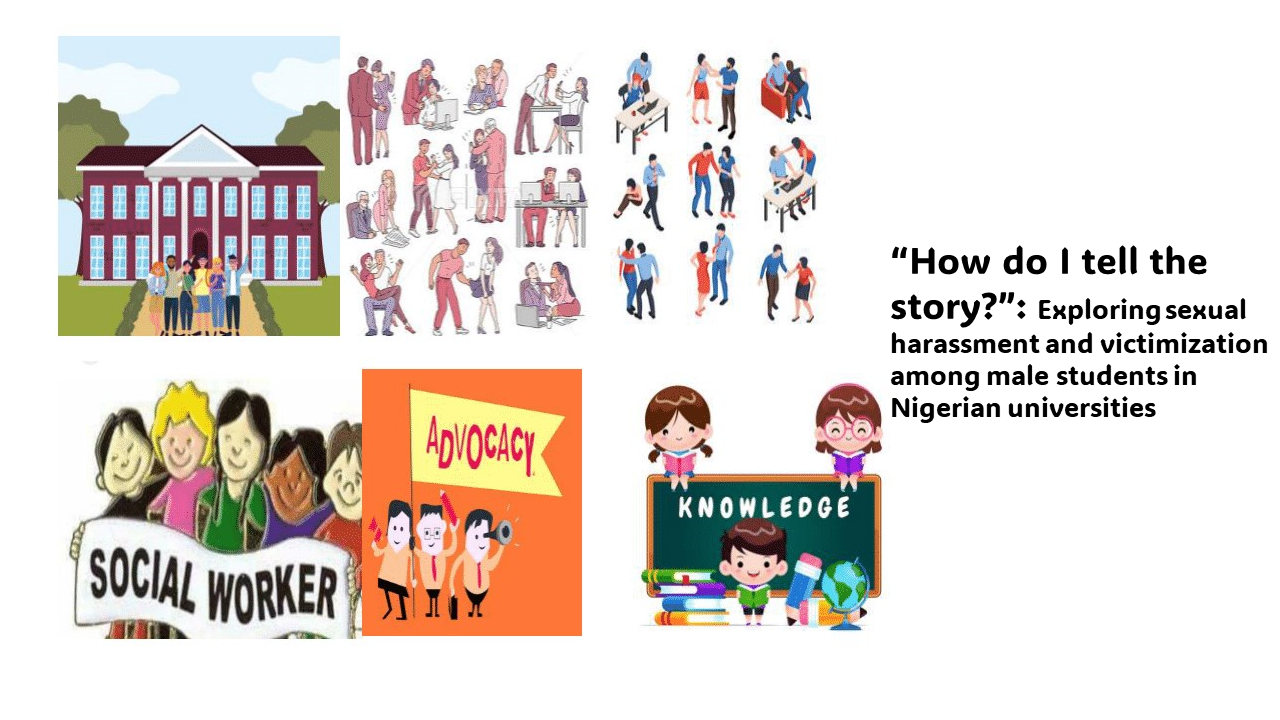“How do I tell the story?”: Exploring sexual harassment and victimization among male students in Nigerian universities
DOI:
https://doi.org/10.14295/bjs.v3i4.544Keywords:
sexual harassment, male students, Nigerian universities, undergraduates, victimization, social workAbstract
The paper investigated the phenomenon of sexual harassment in tertiary institutions in Nigeria. It however differs from the well-trodden path of perceiving sexual harassment as limited to the female gender. Sexual harassment is an old phenomenon that has ravaged societies and institutions for decades but has not yet been fully comprehended as a problem afflicting both genders in the society. Conventionally, sexual harassment was perceived as tool used by men to exhibit dominance over women. Incidentally, the paper utilizing qualitative methods of study discovered that even men (mainly male students and men in lower positions in organizations) experienced sexual harassment at one point or another in their lives. It also found out that these experiences are hardly reported or investigated. This situation derives mainly from the patriarchal nature of the African society where men are not socialized to express their pains and emotions openly as the society sees men as the stronger gender. In view of the foregoing, the paper makes a strong case for the utilization of social work approach among other strategies in tackling the problems faced by these silent victims of sexual harassment in tertiary institutions.
References
Adeokun, A. O. (2005). Sexual harassment in Nigerian educational setting: preliminary notes from a qualitative assessment of Lagos State University. Sexuality in African Magazine, 2.
American Association of University Women (2006). Drawing the line: sexual harassment on campus.
Basile, K.C., & Smith, S. G. (2011). Sexual violence victimization of women: prevalence, characteristics and roles of public healthy and prevention. American Journal of Lifestyle Medicine, 5(5), 407-417. https://doi.org/10.1177/1559827611409512 DOI: https://doi.org/10.1177/1559827611409512
Braun, V., & Clarke, V. (2006). “Using thematic analysis in psychology”. Qualitative Research in Psychology, 3(2), 77-101. DOI: https://doi.org/10.1191/1478088706qp063oa
Bullock, C. M., & Beckson, M. (2011). Male victims of sexual assault: phenomenology psychology, physiology. The Journal of the American Academy of Psychiatry and the Law, 39(2), 197-205.
Carlton, G. (2022). How sexual assault impacts college men and ways to prevent it. In: BestColleges. https://www.bestcolleges.com/blog/campus-sexual.assault-of-men/
Celik, G. G., Tahiroglu, A. Y., Avci, A., Cekin, N., Evliyaoglu, A. Y., & Yoruldu, B. (2012). Sexual abuse in a classroom of ten male students: a group victimization. Journal of Child Sexual Abuse, 21(5), 543-552. https://doi.org/10.1080/10538712.2012.694403 DOI: https://doi.org/10.1080/10538712.2012.694403
Conroy, N. (2013). “Rethinking adolescent peer sexual harassment: contributions of feminist theory. Journal of School Violence, 12(4), 340-356. https://doi.org/10.1080/15388220.2013.813391 DOI: https://doi.org/10.1080/15388220.2013.813391
Denga, D., & Denga, H. (2004). Sexual harassment: a student’s view from a Nigerian University. In: The African Symposium, 4(1). https://www.africabib.org/rec.php?RID=W00072079
Donnelley, D. A., & Kenyon, S. H. (1996). “Honey, we don’t do men”: Gender stereotypes and the provision of services to sexually assaulted males. Journal Interpers Violence, 11(3), 441-448. https://doi.org/10.1177/088626096011003009 DOI: https://doi.org/10.1177/088626096011003009
Donne, M. D., DeLuca, J., Pleskach, P., Bromson, C., Mosley, M. P., Perez, E. T., Matthews, S.G., Stephenson, R., & Frye, V. (2017). Barriers to and facilitators of help-seeking behaviors among men who experience sexual violence. American Journal of Men’s Health, 12, 189-201. https://doi.org/10.1177/1557988317740665 DOI: https://doi.org/10.1177/1557988317740665
Dziech, B. W., & Weiner, L. (1994). The Lecherous Professor: sexual harassment on campus. 2nd ed. Chicago: University of Illinois Press Champaign.
Hail-Jares, K., Lowrey-Kinberg, B. Dunn, K., & Goud, J. B. (2018). False rape allegations: do they lead to a wrongful conviction following the indictment of an innocent defendant? Justice Quarterly, 37(2), 281-303. https://doi.org/10.1080/07418825.2018.1486449 DOI: https://doi.org/10.1080/07418825.2018.1486449
Hickson, F. C., Davies, P. M., Hunt, A. J. Weatherburn, P. McManus, T. J., & Coxon, A. P. (1994). Gay men as victims of nonconsensual sex. Archives of Sexual Behavior, 23, 281-294. https://doi.org/10: 1177/088626096011003009 DOI: https://doi.org/10.1007/BF01541564
Imonikhe, J., Idogho, P., & Aluede, O. (2011). A survey of teachers’ and students perception of sexual harassment in tertiary institutions of Edo State, Nigeria. African Research Review, 5(5), 412-423. http://dx.doi.org/10.4314/afrrev.v5i5.33 DOI: https://doi.org/10.4314/afrrev.v5i5.33
Ladebo, O., & Shopeju, J. (2004). Sexual harassment: perceptions and coping strategies among undergraduate students in Nigeria. Acta Academia. 36(3), 223-238. https://hdl.handle.net/10520/EJC15296
Muoghalu, C. O., & Olaoye, R. I. (2016). Perception of sexual harassment among students of Obafemi Awolowo University Ile Ife, Nigeria. The Nigerian Journal Sociology and Anthropology, 14(2), 140-152. https://doi.org/10.36108/NJSA/6102/14(0290) DOI: https://doi.org/10.36108/NJSA/6102/14(0290)
Oni, H. T., Tshitangano, T., & Akinsola, H. A. (2019). Sexual harassment and victimization of students: a caes study of a higher education institution in South Africa. African Health Sciences, 19(1), 1478-1485. https://dx.doi.org/10.4314/ahs.v19i1.21 DOI: https://doi.org/10.4314/ahs.v19i1.21
Owoaje, E., & Olusola-Taiwo, O. (2010). Sexual harassment experiences of female graduates of Nigerian tertiary institutions. International Quarterly Community Health Education, 30(4), 337-348. https://doi.org/10.2190/IQ.30.4.e DOI: https://doi.org/10.2190/IQ.30.4.e
Patel, V. P. (2023). Social work interventions in addressing sexual harassment: empowerment, advocacy, and healing. International Journal for Multidisciplinary Research, 5(4). https://doi.org/10.36948/ijfmr.2023.v05i04.4619 DOI: https://doi.org/10.36948/ijfmr.2023.v05i04.4619
Patel, R., & Banerjee, S. (2022). Addressing sexual harassment in educational institutions: a social work approach. Indian Journal of Education and Social Change. 18(3), 179-194.
Pauldi, M. A., & Barickman, R. (1991). Definitions and incidence of academic and workplace sexual harassment. Albany, NY: Suny Press, p. 2-5.
Peterson, Z. D., Voller, E. K., Polusny, M. A., & Murdoch, M. (2011). Prevalence and consequences of adult sexual assault of men: review2 of empirical findings and state of the lite4rature. Clinical Psychology Review, 31(1), 1-24. https://doi.org/10.1016/j.cpr.2010.08.006 DOI: https://doi.org/10.1016/j.cpr.2010.08.006
Pearson, J., & Baker, D. (2019). Male rape: what we know, don’t know and need to find out – a critical review. Reviewing Crime Psychology, Chapter, 1st Edition, p 23. DOI: https://doi.org/10.1080/23744006.2019.1591757
Pranther, C., Fuller, T. R., Jeffries, W. I., Marshall, K. J., Howell, A. V., Belyue-Umole, A., & King, W. (2018). Racism, African American women and their sexual reproductive health: a review of historical and contemporary evidence and implications for health equity. Health Enquiry, 2(1), 249-259. https://doi.org/10.1089/heq.2017.0045 DOI: https://doi.org/10.1089/heq.2017.0045
Ruffin, C. M. (2017). School social workers’ roles involving teacher-student sexual misconduct and exploitation. Ph.D. Dissertation. Walden University: Walden Dissertations and Doctoral Studies Collection.
Saraki, O. (2016). Politics: Saraki raises alarm over sexual harassment in Nigerian universities. Nigerian Bulletin, 22 June. Available in https://www.vanguardngr.com/2016/06/saraki-raises-alarm-spate-sexual-harassment-tertiary-institutions/ Access in March 18, 2024.
Shaftcraft, C. (2004). Educator sexual misconduct: a synthesis of existing literature. PPSS 204-09. US Department of Education.
Stephenson, R., Rentsch, C., Salazar, L.F., & Sullivan, P. S. (2011). Characteristics and intimate partner violence among men who have sex with men. West Journal of Emergency Medicine, 12(3), 324-332. https://www.ncbi.nlm.nih.gov/pmc/articles/PMC3117609/
Thomas, J. C., & Kopel, J. (2023). Male victims of sexual assault: a review of the literature. Behavioral Sciences, 13(4), 304. https://doi.org/10.3390/bs13040304 DOI: https://doi.org/10.3390/bs13040304
Tripathi, S. (2016). A critical analysis of role of social workers for sexually abused females and children. Slideshare. Available in https://www.slideshare.net/suchimitatripathi/critically-analyse-the-role-of-social-worker Access in March 18, 2024.
University of Nevada, Reno (2023). Types of abuse in a relationship and how social workers can help. Online Degrees News and Articles. Available in https://onlinedegrees.unr.edu/blog/types-of-abuse-in-arelationship/ Access in March 18, 2024.
Whitton, S.W., Dyar, C., Mustanski, B., & Newcomb, M. E. (2019). Intimate partner violence experiences of sexual and gender minority adolescents and young adults assigned female at birth. Psycholgy of Women Quarerly, 43(2), 232-249. https://doi.org/10.1177/0361684319838972 DOI: https://doi.org/10.1177/0361684319838972

Downloads
Published
How to Cite
Issue
Section
License
Copyright (c) 2024 Kenechukwu Nwakego Anugwom

This work is licensed under a Creative Commons Attribution 4.0 International License.
Authors who publish with this journal agree to the following terms:
1) Authors retain copyright and grant the journal right of first publication with the work simultaneously licensed under a Creative Commons Attribution License that allows others to share the work with an acknowledgement of the work's authorship and initial publication in this journal.
2) Authors are able to enter into separate, additional contractual arrangements for the non-exclusive distribution of the journal's published version of the work (e.g., post it to an institutional repository or publish it in a book), with an acknowledgement of its initial publication in this journal.
3) Authors are permitted and encouraged to post their work online (e.g., in institutional repositories or on their website) prior to and during the submission process, as it can lead to productive exchanges, as well as earlier and greater citation of published work.




